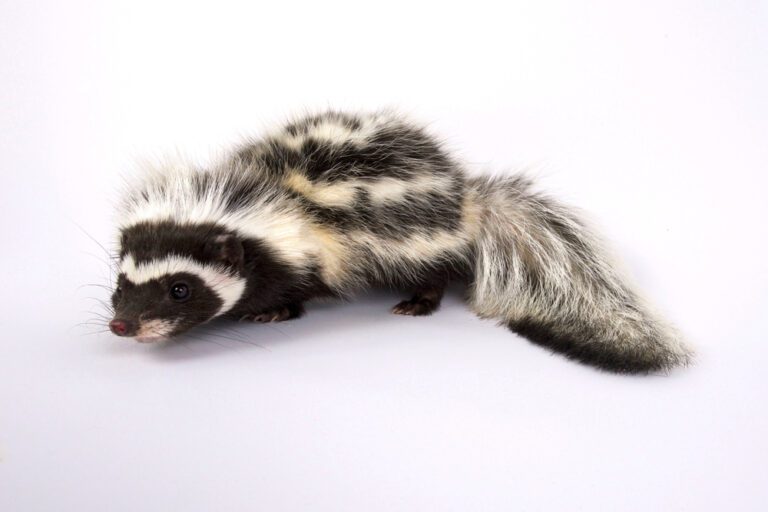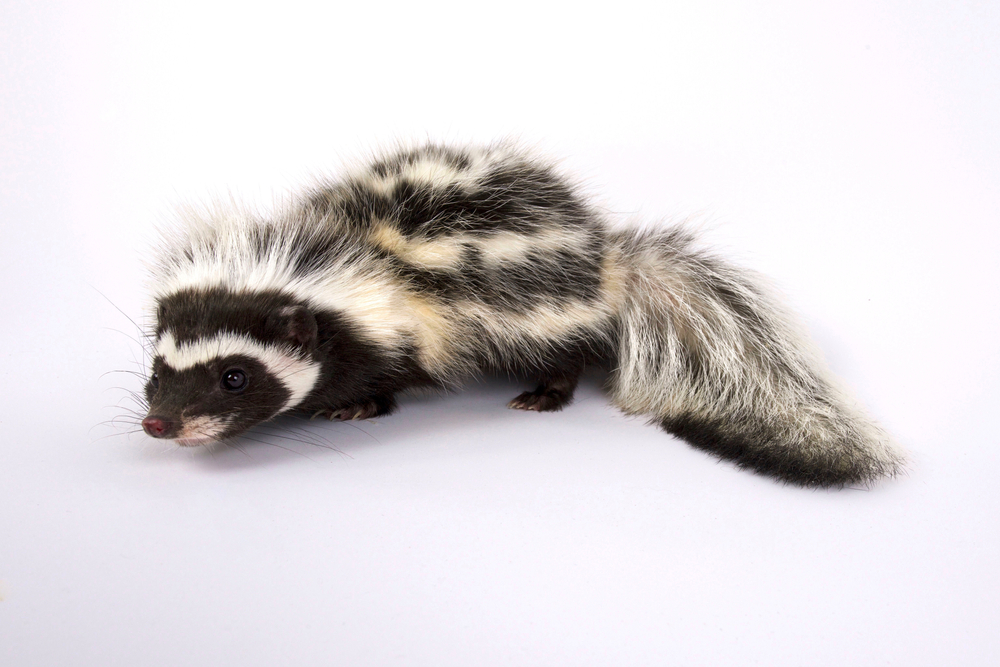
[ad_1]

Striped polecats (Ictonyx striatus), or the African zorilla, are small carnivores that look like North American skunks but aren’t. They’re more closely related to weasels and have smaller, slender bodies.
There are plenty of fun facts about this creature, like what they actually use a stink gland for, and more. Let’s take a closer look at the striped polecat.
1. Striped Polecats Are the Skunk’s Doppelgänger
(Credit: Karel Bock/Getty Images)
If a striped polecat looked at a North American skunk or vice versa, they might think they were looking in a mirror. Striped polecats have a coarse, thick black coat with white patches and stripes. However, the difference between their coat lies in the patterns of their coloring. Striped polecats have a white patch on their foreheads and white underneath their ears.
Four thick white stripes line the animal’s body, and they have long claws. Skunks do not have white patches on their heads and instead have one thin white stripe that runs from the top of their head to the beginning of their snout. Though they may look alike, the polecat is definitely not a skunk.
Read More: A Brief History of the Hand-standing Skunk
2. They are Related to Domestic Ferrets
Polecats are a type of carnivore in the Mustelidae family, which also includes ferrets, fishers, otters, and badgers. Animals in this family have long bodies, thick fur, small round ears, and stumpy legs. Zorillas are part of the Ictonychinae, a subfamily of mustelids. Domestic ferrets are also categorized in the Mustelidae family.
Read More: Otters, Beavers And Other Semiaquatic Mammals Keep Clean Underwater, Thanks To Their Flexible Fur
3. Their Name Is Spanish for Fox
(Credit: Michal Sloviak/Shutterstock)
Their name, zorilla, stems from the word ‘zorro or zorra’ for fox. The word zorillo in Spanish is also the word for the skunk. But really! They are not skunks. Striped polecats are known as Zorille, too.
Read More: 10 Animal Names That Have You Fooled
4. Striped Polecats Scream
When threatened by other animals, or frequently domestic dogs, the polecat will fluff themselves up and growl and bark. The striped polecat will begin to scream if the warning isn’t enough to drive away the threat.
After the high-pitched warning, the polecat will spray the unfortunate attacker with the worst-smelling secretion. But, if this isn’t enough to drive away the predators, the malodorous animals play dead. Scientists suspect that the secretions also make the striped polecat taste awful. So they might escape the jaws of death. Literally.
Read More: What Are the Loudest Animals in the World?
5. They Have a Stink Gland
(Credit: Michal Sloviak/Shutterstock)
Striped pole cats do have a stink gland and will spray when threatened or cornered. Their scent comes from their anal gland and is smellier than skunk’s spray. It’s so strong that it can temporarily blind predators. You can thank sulfur for the terrible smell.
But still, not a skunk.
Read More: These 6 Animals Are Attracted to Weird Scents
6. Striped Polecats Feast on Tiny Rodents and Amphibians
Striped polecats crave meat, and with 34 teeth, they easily shred their lunch. They will eat mice, rats, and even hares. But they will also catch an aquatic snack. They will eat frogs, small snakes, lizards, some birds and their eggs, and insects.
Read More: Who Is at the Top of the Food Chain?
7. They are Native to the African Continent
The striped polecat is commonly found in the African savanna. However, it can also live in dunes in the Namib desert and Zimbabwe’s forests, mountains, and swamps. Other species of polecats are found in Europe and Asia.
Read More: These Rare Adaptations Help Animals Survive in the Desert
8. Striped Polecats are Nocturnal
The striped polecat or zorilla belongs to the night. These mammals are nocturnal but also search for food right before the sun rises or sets. During the day, striped pole cats sleep in trees or between rocks. They might also dig themselves into a burrow and cover themselves with a blanket of twigs and leaves.
Read More: 5 Animals That You’ll Only Have a Chance to See at Night
9. Striped Polecats are Introverted Creatures
In the wild, striped polecats are solitary and are often seen on their own. Males and females only interact with each other when it is time to mate. Otherwise, striped polecats are aggressive with each other.
Read More: 5 Introverted Animals
10. They Used to be In the Same Family as Skunks
Okay, so now you really may be thinking, “Are you sure they are not skunks? They spray like skunks and look like skunks, so why is it not a skunk?”
In the 1990s, a group of scientists used molecular analysis to show that skunks and polecats are in different subfamilies despite looking similar. Skunks are now part of their own family called Mephitidae, which also categorizes stink badgers. The polecat was once thought to be the ‘Old World’s’ skunk. But today, it remains not a skunk.
Read More: 6 Animals With Funny Names You’ve Probably Never Heard Of
Article Sources:
Our writers at Discovermagazine.com use peer-reviewed studies and high-quality sources for our articles, and our editors review them for accuracy and trustworthiness. Review the sources used below for this article:
[ad_2]